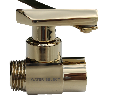
Conservation With Immediate Effect
Reduce water use from 20% to 70% in the shower.
A huge return on investment -
© 2013 Water Select® All Rights Reserved.


Imagine What’ll Happen if We Fail to Stop 10°F Warming. The Earth has warmed only
a bit more than 1°F since the catastrophic Dust Bowl, and we are poised to warm an
astounding 9-
We’re Already Topping Dust Bowl Temperatures
In general, we expect the greatest number of temperature records to be set during a widespread drought. I explained why that is that the case in my Nature article last year on “The next dust bowl” ( full text here):
Warming causes greater evaporation and, once the ground is dry, the Sun’s energy
goes into baking the soil, leading to a further increase in air temperature. That
is why, for instance, so many temperature records were set for the United States
in the 1930s Dust Bowl; and why, in 2011, drought-
Why is this bad news? Because the Earth has warmed only a bit more than 1°F since
the catastrophic Dust Bowl — and we are poised to warm an astounding 9-
Much as our current monster heat wave has been made worse by human activity (man-
The drought came in three waves, 1934, 1936, and 1939-
For discussion of some of those land management practices, see here.
Unfortunately, while we have improved much of our land management since then, we
have chosen to ignore decades of warning by climate scientists that unrestricted
emissions of greenhouse gases would cause ever-
Aiguo Dai of the National Center for Atmospheric Research, in his 2010 study, “ Drought
under global warming: a review,” had a similar conclusion. I will blog shortly on
his updated findings, but here is a rough representation of where his analysis projects
the PDSI [Palmer Drought Severity Index] will be soon after mid-



Water Select®
Conserve Water
BUY NOW


The PDSI in a moderate emissions scenario soon after mid-
Dai found that:
By the end of the century, many populated areas, including parts of the United States
and much of the Mediterranean and Africa, could face readings in the range of -
Whereas in the 1930s, you could certainly make a case that people didn’t know just
how destructive their land management practices were. But we have been warned again
and again that we face ever-
• In 2007, Science (subs. req’d) published research that “ predicted a permanent drought by 2050 throughout the Southwest” — levels of aridity comparable to the 1930s Dust Bowl would stretch from Kansas to California. And they were also only looking at a 720 ppm case.
• In December 2008, the Bush Administration quietly released a US Geological Survey stunner: SW faces “permanent drying” by 2050, which found:
The serious hydrological changes and impacts known to have occurred in both historic
and prehistoric times over North America reflect large-
